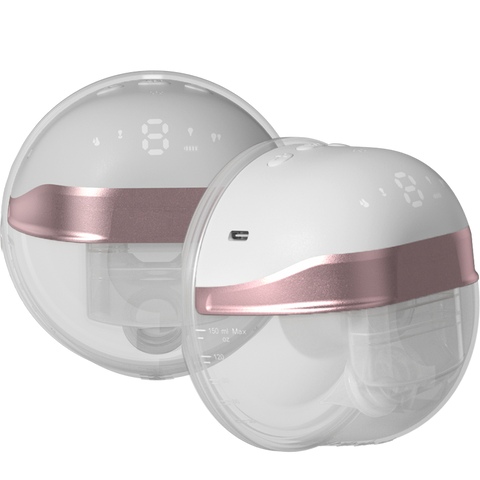Learning how to pump breast milk can be a very handy skill for new parents to have. Whether your baby is struggling to latch, you’re returning to work, or you want to share feeding responsibilities with your partner, pumping can be beneficial for many different reasons.
However, pumping can also be a tricky skill to master, and you might need a few breast pumping tips from others to help you and your baby get the most out of it. That’s why we’ve put together a list of our top tips for pumping and storing breast milk to help you navigate the entire process with ease. Keep on reading to learn more, and allow Milkeaze to help you on the path to pumping success!
1. Establish the Best Time to Start Pumping

Generally, it is recommended to wait until a few weeks after your baby is born before you start pumping your breast milk. This can allow your milk supply to regulate and will help you establish a proper breastfeeding routine for you to use as a guide when pumping. However, everyone’s circumstances are different, and this timeline is usually only recommended when a baby is breastfed, healthy, easily putting on weight, and was born full-term.
In some cases, it can be better to begin expressing milk straight after your baby is born. Ultimately, the best time to start pumping depends on a number of different considerations, and it’s best to establish this with your midwife or lactation specialist as soon as you can. There are a variety of different factors that may affect this decision, including:
- Whether you plan to breastfeed or pump full-time
- Whether your baby is able to breastfeed straight away
- How frequently you need to express your breast milk
- Whether you need to be separated from your new baby due to illness or other factors
2. Use a High-Quality Breast Pump

One of the best pumping tips we can give you is to invest in a high-quality electric breast pump that suits your needs. We’d suggest looking for a double pump that is efficient, comfortable, and has adjustable settings to mimic your baby's breastfeeding patterns.
If the pump is hands-free, this can be even better. A hands-free pump, such as our Joey pump, will give you the freedom to express on the go. This will allow you to continue on with your day without having to devote time solely to pumping.
3. Familiarise Yourself With Proper Storage Guidelines

Proper storage is essential in maintaining the quality and safety of breast milk for your baby. Storage guidelines for breast milk can vary depending on whether the milk is fresh, chilled, frozen, or thawed. General advice that can be useful to remember includes:
- Using sterile containers (like our storage bags) to store the milk
- Clearly labelling the date of expression on the containers
- Following safe handling practices at all times
- Disposing of any thawed milk that is leftover after a feeding session
In Australia, Healthdirect provides recommendations for storing and handling breast milk, including temperature guidelines, safe storage times, and when to dispose of stored breast milk.
It's important to note that these are general guidelines, and the shelf life of breast milk can vary depending on various factors, such as the temperature and sanitation of the storage area. If you have any questions or concerns, we suggest discussing these with a healthcare professional such as your GP or midwife.
Following proper healthcare advice and storage guidelines will ensure your baby receives the freshest milk with the highest nutritional value while minimising the risk of contamination and spoilage.
4. Find Ways to Relax

We get it — Reducing your stress and finding ways to relax when you’re looking after a new baby is easier said than done, but it’s still important! Not only is it necessary for your well-being, but it’s also beneficial for pumping as well.
While stress doesn’t impact the milk supply itself, it can interfere with your letdown reflex and cause your milk flow to be slower than usual. This is because stress hormones, such as cortisol, can suppress your oxytocin, which is the hormone responsible for triggering your letdown reflex.
The good news is that practising relaxation techniques can reduce these stress hormones and make it easier for you to pump more efficiently. If you’re struggling to relax while you pump, there are a number of relaxation tips for you to try that can make expressing milk easier, such as:
- Listening to calming music
- Performing deep breathing exercises
- Having your partner massage your shoulders
- Looking at pictures of your baby
- Picturing your baby breastfeeding
- Pumping in a quiet, comfortable spot without distractions
5. Use Hands-On Techniques
Another top recommendation is to use hands-on methods such as breast compressions and massage techniques when you pump. These hands-on pumping tips can help you stimulate flow and maximise the amount of milk you get out of each pumping session.
Breast Compressions
To do breast compressions while expressing milk, place your hand in a C-shape around your breast so your thumb is on top and your fingers are on the underside. Take care not to place your hand too close to the nipple, as this could cause discomfort, impede milk flow, and even interfere with the positioning of your pump.
Once your hand is correctly placed around your breast, you will then need to apply gentle pressure towards the chest wall. Doing so will allow for more effective compression of the milk ducts without placing undue pressure on the nipple. This process can be done one breast at a time, or if you have a double pump, you can perform these compressions on both breasts simultaneously.
Breast Massages
Breast massages have similar results to compressions, but rather than working on the entire breast, you’ll be applying pressure to specific areas. You can massage your breasts by placing your middle and pointer fingers firmly together and extending them to apply gentle, focused pressure to each breast in a circular motion.
You can use this technique to massage the entire breast when expressing milk, including the underside and near the armpit. However, it can also be used to apply focused pressure on areas that may feel particularly full or hard when compared to the rest of the breast.
6. Make Sure You’re Sitting Comfortably

If you’re wondering how to sit when pumping breast milk, it’s best to sit in an upright position where your shoulders are set and your back is straight. It’s important to find a comfortable, padded chair that promotes good posture and has armrests to help support you while you pump. As well as a comfortable chair, you may benefit from using a good footrest and placing a firm pillow behind your back for added comfort and increased support.
7. Stay Hydrated, Nourished, and Well-Rested

Getting adequate sleep, staying nourished, and eating a balanced diet is important for everyone, but it’s especially important when you’re breastfeeding and pumping. Producing a consistent supply of breast milk uses up a lot of nutrients and requires a fair amount of your body’s energy.
We recommend eating at regular intervals, consuming a varied, nutritious diet, drinking plenty of water, and getting as much sleep as you can throughout the day and night. Doing so will help you stay healthy, hydrated, and energised as you continue to feed and care for your baby.
8. Don’t Forget to Take Breaks

One of the most significant breast pumping tips we can give you is to take breaks. Expressing milk can be hard work, and it’s essential to have some downtime occasionally to prevent discomfort and allow yourself time to rest and recuperate. If you’re starting to get uncomfortable, your nipples feel sore, or you can feel yourself getting tired, listen to your body and press pause on your pumping session.
Not only are regular pumping breaks good for your self-care, but they also give your breasts time to rest and fully replenish their supply. By taking breaks when you need them, you’re ensuring there is enough time for milk to be produced when you return to your pumping session. In turn, this can help to prevent overproduction and lead to more effective milk flow.
9. Connect With Your Community

The importance of finding community cannot be overstated, especially if you’re a new mum looking for a little extra guidance and support. Joining breastfeeding support forums online, attending mums groups in your local area, and connecting with others who have experience with breastfeeding and pumping can make a world of difference. These groups can provide you with encouragement, advice, and additional breast pumping tips to give you the information, confidence, and support you need.


Leave a comment